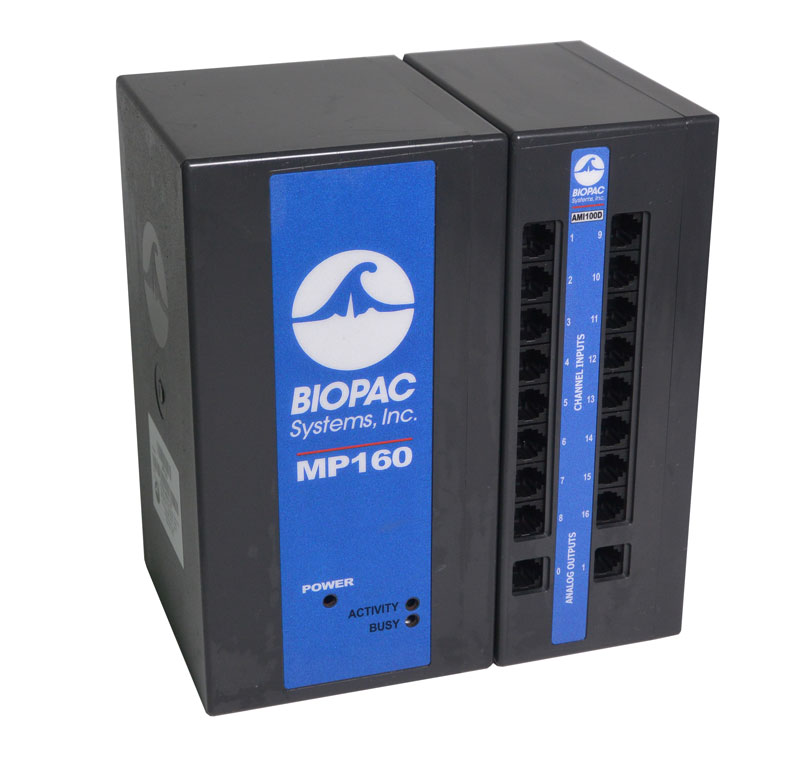External Devices and Channel Contention
Channel contention must be considered when connecting the analog output sourcing from external devices to an MP1X0 Data Acquisition System. Considerations for MP160 or MP150 users follow; MP100 users should refer to Channel Contention Issues for MP100 near the end of this page.
MP160 or MP150 Users

To connect external device outputs to the MP160 or MP150:
- Non-human subjects or only collecting data from external devices—If the MP System is only collecting signals from non-human subjects (via MP system amplifier modules) or if the MP System is only collecting data from external devices:
- Connect external device output signal to an unused AMI100D/HLT100C input channel (1-16).
- Human subjects—If the MP System is collecting signals from human subjects (via MP system amplifier modules), it’s important to isolate the external device output signal from the MP System input:
- Connect external device output signal to an unused AMI100D/HLT100C input channel (1-16) via INISOA.
Note: If all amps making electrical connection are BioNomadix amplifiers, isolating external devices is not required.
Channel contention issues
- If an analog channel is used on the AMI100D or HLT100C, make certain that two external devices do not use the same analog channel.
- If amplifier modules are connected to the MP System, then those amplifier modules must be set to a channel that is not used by external devices plugged into the AMI100D or HLT100C.
- Wired amplifiers such as the ECG100C are set to the channel by the red channel switch on the top of the unit.
- Wireless BioNomadix units, such as the BN-RSPEC, use two channels (except for the BN-ACCL3, which uses three). These are indicated by the switches on the front of the units.
- Smart Amplifiers such as the ECG100D or EMG100D must be plugged into the AMI100D. They are not compatible with the HLT100C.
- Smart Amplifiers require their own individual channel as would any external device.
Example:
Two external device outputs and an EMG100C amplifier are connected to the MP160 system and connected to a human subject.
– Device one is a force plate
– Device two is a strain gauge
– The EMG100C measures the subject’s muscle activity
In this case, to fully isolate the human subject:
- Both the force plate and the gauge outputs should be connected to the MP160 inputs via the AMI100D, using one INISOA for each input channel.
- The EMG100C should be snapped directly to the MP160 System and connected directly to the subject with the appropriate leads and electrodes.
- Assuming the force plate is connected via INISOA to AMI100D channel 1 and the strain gauge is connected via INISOA to AMI100D channel 2, then the EMG100C amplifier must be set to a channel between 3-16, as signified by the red switch on the top of the amplifier.
- The EMG100C cannot use channel 1 or channel 2 because, in this example, those channels are being used by the force plate and strain gauge.
Channel Contention Issues for MP100
- If an analog channel is used on the UIM100C or HLT100C, make certain that two external devices do not use the same analog channel.
- If amplifier modules are connected to the MP System, then those amplifier modules must be set to a channel which is not used by external devices plugged into the UIM100C or HLT100C.
For example
Two external device outputs and an ECG100C amplifier are connected to the MP100 system and connected to a human subject.
- Device one is a Noninvasive Blood Pressure (NIBP) monitor
- Device two is an electronic scale
- The ECG100C module measures the subject’s electrocardiogram
In this case, to fully isolate the human subject:
- Both the NIBP monitor and the electronic scale outputs should be connected to the MP100 inputs via the HLT100C*, using one INISO for each input channel.
- The ECG100C should be snapped directly to the MP100 System and connected directly to the subject with the appropriate leads and electrodes.
- Assuming the NIBP is connected via INISO to HLT100C channel 1 and the Electronic Scale is connected via INISO to HLT100C channel 2, then the ECG100C amplifier must be set to a channel between 3-16.
- The ECG100C can’t use Channels 1 and 2 because other devices are using both channels.
*pre-2016 model or HLT100C-MP150
Associated Applications
- fNIRS Functional Near Infrared Optical Brain Imaging
- ICG: Impedance Cardiography/Cardiac Output
- Laser Doppler Flow
- Magnetic Resonance Imaging with BIOPAC Equipment
- MER: Micro-electrode Recording
- NIBP: Noninvasive Blood Pressure
- Noninvasive Blood Pressure Monitoring – Human
- Plethysmography
- Remote Monitoring
- Respiration | Pulmonary Function
- Sleep Studies
- Vibromyography (VMG) – Muscle Activity
Stay Connected